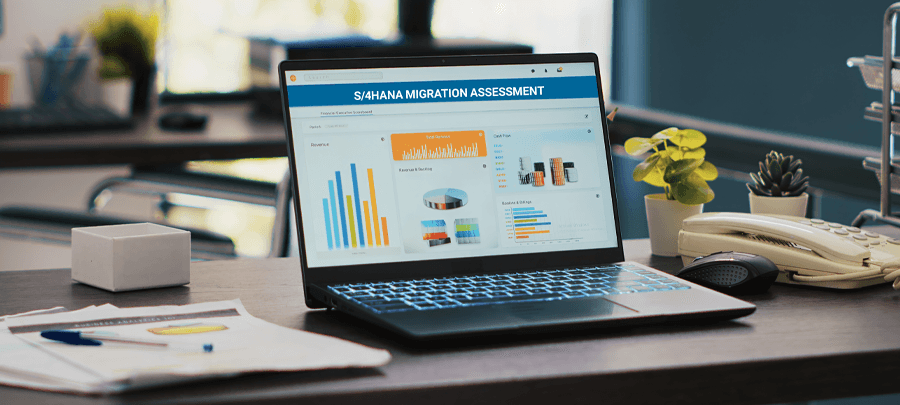3 key things to consider prior to an SAP S/4HANA implementation
14 December 2022


Norb Brumbergs
Senior Vice President - SAP DeliveryNorb Brumbergs is Vice President, SAP Delivery at Applexus. He is a senior Information Technology and Program Management executive with over 30 years of management expertise....
Are you ready to modernize your information technology platform because it is a set of outdated legacy systems that no longer supports your business adequately? Today’s technology provides innovative solutions that bring more value, streamline processes, improve business agility, accelerate efficiency, and improve the bottom line. They can help scale, grow, and transform your business into an industry-leading entity. Many organizations are migrating from SAP ECC to S/4HANA or implementing SAP for the first time with S/4HANA. The key to success is getting started the right way.
Organizations looking to initiate an SAP S/4HANA transformation will want to ensure their investment brings value and the costs have a level of certainty preventing the program from becoming a money pit. They will want to ensure the project is in sync with business objectives, ensures your leaders and resources adapt to the change and will continue to derive optimum value over the lifetime of the solution. Staying on track requires top-down strategic and careful planning that follows the golden rules of a S/4HANA implementation
Getting the S/4HANA initiative right without a reliable set of guidelines can be tricky. Many decision-makers don’t know where to start and more often than not end up starting on the wrong foot which is evidenced by irregular and unpredictable follow on projects resulting in wasted time, energy and money while deferring the expected benefits. To avoid these issues and maximize the value of your investment, I have put together the 3 critical areas, that businesses need to focus on to make the S/4HANA program successful. Let’s dive in.

Establish your Case for Change
People think that your case for change is just a high-level business case along with the associated ROI. I think it is much more than that. It needs to answer the compelling question “Why are you doing this?”
Is your current solution, out-of-date, end-of-life, or no longer scalable? Do you need something better to remain competitive? Is it something else? Every company is unique. Getting it right and communicating with your team and any partners will be critical to your success.
The business case should align with the real value you want to receive. At Applexus we suggest a value map that decomposes the high-level benefits all the way to the capabilities that will be enabled by your new solution.
As you clearly define your scope, the processes you select should tie directly to the capabilities that drive value. At Applexus we recommend process mining to identify which processes are inefficient and where improvement will lead to high-value use cases.
Another angle on the process is to identify which processes are truly unique to your business or your brand and are worth additional investment in your solution. Those that are really commodity processes - that are mostly standard across the industry, should follow SAP best practices and avoid low-value enhancements.
Once the case for change is well defined, make sure your team understands and embraces it as project boundaries and where is and is not OK to deviate from standard. This will help ensure low-value pet perks are easily dismissed and kept out of scope.
Remember, your case for change is more than the business case, it needs to clearly define your mission and objectives and where you are expecting to get value. Then it needs to be communicated and enforced with the project team. This type of project is usually a once-in-a-generation investment. Getting your case for change right is your first step to getting it right.
Now that we have covered how to go about developing a business case, let’s get into the “Why’s” and “How’s” of developing a roadmap, without which you’re S/4HANA program is likely to wander, lose focus, and sub-optimize the results.
Build your Roadmap
Many consultants will talk to you about Brownfield vs. Greenfield, but that is very shortsighted and does not get you to the goal of a value-driven digital transformation. At Applexus, we have developed something we call the Runway Approach to Digital Transformation. We start with evaluating your current organization and landscape on these criteria:
- Complexity of the current landscape
- Adaptability to change
- Risk aversion during the transformation process
Then we align it with your case for change.
Assessments of your current processes, data, application architecture, custom code, and infrastructure will provide an understanding of how complex your current landscape is. The more complex the more likely you will need to begin with some cleanup activities or a back-to-basics approach starting with industry best practices.
An assessment of your people and organization will determine if your organization will be able to adapt to a brand-new solution or if there will need to be extensive modifications to align with how they are used to doing things. The key will be to limit changes to those that are supported by the case for change discussed last time.
Your company’s position in the market, current business conditions along with people assessment will determine how much risk your company is willing to take. This input will drive much of the approach taken in your roadmap to balance risk mitigation with time and cost. If risk aversion is high, you can check out my cFIN video.
Evaluation of these three criteria does not result in a binary yes or no. Each has a sliding scale and may be weighted differently. This is why the binary brown vs green does not work.

If you are adaptable, OK with some risk and your landscape is ripe for simplification, then you will want to consider a roadmap generally based on our FreshStart approach. Your early projects will focus on building a new solution without the baggage of legacy.
If your landscape is relatively straightforward, and your organization is resistant to change with moderate risk aversion you may want to focus on our JumpStart approach which is focused on getting you to the S/4HANA platform as quickly as possible. Then, over time, your roadmap will include smaller projects to further optimize your processes.
Our third approach, CleanStart is sort of a compromise to reduce risk and mitigate resistance to change. Here we focus on cleaning and/or simplifying your current landscape before you make what turns into a simpler migration to S/4HANA.
I can’t emphasize enough that every company is going to be different. Cost and time pressures can significantly influence your roadmap approach. A proper set of assessments will provide the input to create a roadmap to transition to SAP S/4HANA in the best way for your company.
With a Case for Change and a Roadmap in hand that establishes the “Why” and plots the projects to be included in your journey, let’s talk about the people you need, to make sure it is successful. People are significant assets and indispensable to your S/4HANA program, so getting this part right will determine how well you can execute the program and the level of user adoption you will get when the solution is delivered.
Identify and ready your people
To get anything done you need people, and those people need to be led, understand the mission, and know how to go about fulfilling it.
Start with an executive sponsor that will show day-to-day visible leadership and reinforce the mission and objectives of the program. This should be a senior executive that is bought into the value case and able to stay close enough to the program to keep the team reminded of the case for change and corresponding boundaries.
Create a Steering Committee of executives as an extension of your program sponsor. Get them aligned on the case for change and the project approach. Most transformation programs span multiple lines of business and in turn multiple executive stakeholders. The Steering Committee will ensure the team understands the case for change and will govern schedule adherence and project budget.
Rarely is everything in an S/4 program going to be easy for everybody. Usually, one area takes on additional work to optimize the process across the organization. These executives need to facilitate the direction in the best interests of the organization even if it creates some pain in their area.
The next layer is the project team itself. Build a team of your best people from the business operations and IT and devote them 100% to the project. Find the people that will be future leaders of the organization and thoroughly understand your business. These need to be the forward-thinking people that tend to be innovative, questioning, and driven to accomplish the program as quickly as possible. You will miss these people in your daily operations.
As a result, these leaders will be armed with deep knowledge of the solution as they rejoin the business operations and will influence the level of adoption and success of the new solution in achieving the value case.
Finally, get the team trained before the program starts. They should learn about SAP, how it is structured, and the intention of the approach taken by SAP. They should learn the SAP Activate methodology or something similar to Applexus RunningStart. And finally, they need to adopt a cloud mindset to apply key concepts such as fit-to-standard and agile to help simplify what usually becomes a very complex initiative.
Get the PEOPLE dimension right and your SAP S/4 program will bring home the benefits you expected when you signed up for this digital transformation.
Wrap Up
If you don't know where you are going, any road will get you there. - Lewis Carroll
S/4HANA implementations can be a complex and expensive undertaking for any Enterprise and you do not want to take just any road. Getting your destination right comes down to how you get started. Nailing down the “Why”, “Where” and “Who” will provide a clear foundation with goals, a roadmap, and the people needed to get the job done. The road to S/4HANA may seem intimidating, but with the right setup and guidance, it can become a manageable process.
If you’re having a hard time getting started, then it would be best to work with an SAP partner such as Applexus to navigate through the 3 areas discussed above and set up a solid foundation for your transition to SAP S/4HANA. They can take you from discovery to deployment. Applexus experts, accelerators, a data-driven approach, unique methodologies, proven industry-wide familiarity, and other differentiators will put you on the right path and support you to achieve your key S/4HANA objectives in the shortest time within the right budget. Our business-led and IT-enabled approach maps all the objectives, anticipates challenges, aligns stakeholders, and weighs costs and benefits to realize a successful S/4HANA program.












